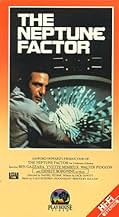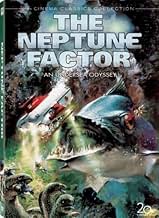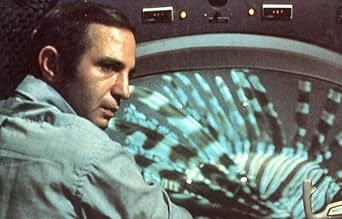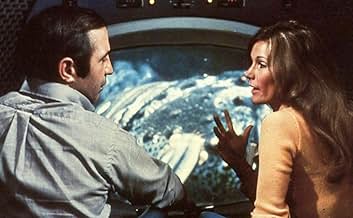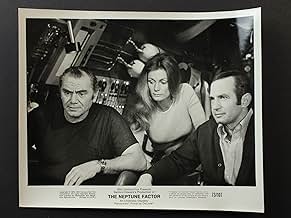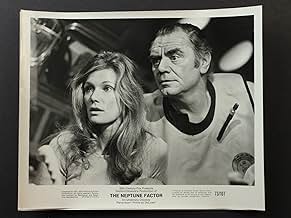CALIFICACIÓN DE IMDb
4.4/10
1.4 k
TU CALIFICACIÓN
Agrega una trama en tu idiomaWhen an underwater ocean lab is lost in a earthquake, an advanced submarine is sent down to find it and encounters terrible danger.When an underwater ocean lab is lost in a earthquake, an advanced submarine is sent down to find it and encounters terrible danger.When an underwater ocean lab is lost in a earthquake, an advanced submarine is sent down to find it and encounters terrible danger.
- Dirección
- Guionista
- Elenco
- Premios
- 1 nominación en total
Ken Pogue
- Diver Thomas
- (as Kenneth Pogue)
- Dirección
- Guionista
- Todo el elenco y el equipo
- Producción, taquilla y más en IMDbPro
Opiniones destacadas
If I didn't know any better, I would say The Neptune Factor is a subtle parody on the "disaster Genre" movies of the 1970s. It is certainly not "Airplane", a zany take on the disaster genre, but rather an understated satire. The Rear screen projection of aquarium fish, only adds to the surreal, hypnotic affect this movie had on me. To quote Kirk Douglas from the Disney classic 20,000 Leagues Under the Sea, "Why I've seen scarier fish in my Aunt Fannie's gold fish bowl". Amazing what a little imagination and creativity can do for a parody of a low budget movie.
The Neptune Factor deals with some scientists who live and work out of an undersea lab in the Atlantic Ocean. One fine day while their bosses, Walter Pidgeon, Yvette Mimieux, and Ernest Borgnine are up top, an earthquake occurs and the lab topples over into an underwater crevice.
Though an atomic power submarine could stay down there indefinitely the problem is that crevice is way too small for one of those big boys. A smaller type submarine able to withstand the pressures of the very deep is needed and that's where Ben Gazzara and his ship the Neptune come in.
As disaster films go The Neptune Factor is small potatoes special effects wise. It's a Canadian production and I've seen Hollywood come up with worse films spending a ton more money than was done here.
The special effects such as they are, are merely movie films of some ordinary species of marine life blown up several times their size, because these are the creatures the crew finds down at depths that man hasn't been before. It's beautiful undersea photography just like a trip to Marineland.
It's a no frills production, no subplots of any kind, no social interaction of any kind with the crew, just do the mission and go home. That's why it was given a G rating when first released.
If you love Jacques Cousteau, you'll love this film.
Though an atomic power submarine could stay down there indefinitely the problem is that crevice is way too small for one of those big boys. A smaller type submarine able to withstand the pressures of the very deep is needed and that's where Ben Gazzara and his ship the Neptune come in.
As disaster films go The Neptune Factor is small potatoes special effects wise. It's a Canadian production and I've seen Hollywood come up with worse films spending a ton more money than was done here.
The special effects such as they are, are merely movie films of some ordinary species of marine life blown up several times their size, because these are the creatures the crew finds down at depths that man hasn't been before. It's beautiful undersea photography just like a trip to Marineland.
It's a no frills production, no subplots of any kind, no social interaction of any kind with the crew, just do the mission and go home. That's why it was given a G rating when first released.
If you love Jacques Cousteau, you'll love this film.
Wow, an underwater film shot completely on location - at the bottom of the production designers' fishtank! This action-drama basically involves about 80 minutes of the main characters staring out of their mini-sub's windshield/projection screen with awestruck expressions at... grainily blown up shots of common acquarium fish. The "model shots" (a generous naming) actually DO look to have been shot in a common home aquarium, complete with plastic ferns and oversize gravel. The stretch is so great, the disparity so big, I didn't know whether to laugh or cry. I think in the end I simply gave up and decided to vomit. Not sure how Walter Pidgeon took a wrong turn into this turkey, but it is worth noting that about half the cast of "The Black Hole" is featured here - doubtless in a dry run for their performances in that later classic...
For a movie about a race against the clock to rescue a group of scientists trapped in an undersea research facility that's been hit by an earthquake, The Neptune Factor is incredibly dull. The problem is that for most of the movie, nothing happens. Ernest Borgnine (who I'll give a little credit as he does his best with this snoozer of a script), Ben Gazzara, and company spend most of the movie on a slow motion tour of the ocean floor looking for their missing colleagues. Garzzara is the worst, showing the same kind of emotion usually reserved for everyday, mundane tasks like doing the laundry or grocery shopping. You'd hardly know from his demeanor that the lives of three people rest in his hands. And when something does finally happen the special effects are so ridiculous looking that the movie losses any credibility it might have had. The "giant" sea creatures the rescuers run into are little more than normal salt water aquarium fish filmed with a zoom lens and a bad looking miniature of the submarine. That's right - The Neptune Factor looks like it was filmed in someone's home aquarium. A giant clown fish - oooooh, how scary! There's nothing much more frightening than the sight of a ludicrously large Nemo.
To say I was disappointed by The Neptune Factor would be a gross understatement. A good cast is put to waste with nothing to do. In the end, I've got to rate this one a 2/10.
To say I was disappointed by The Neptune Factor would be a gross understatement. A good cast is put to waste with nothing to do. In the end, I've got to rate this one a 2/10.
Not as exciting as the box cover artwork might suggest, with a painfully stilted characterisation by Ben Gazzara and capable supporting cast trapped in one-dimensional roles. The story concerns militant, officious salvage expert (Gazzara) contracted by an aquatic research team to recover a stricken underwater manned probe that has descended into a deep sea ravine. Gazzara makes it clear from the outset that his goal is only to locate the vessel for insurance purposes, except Mimieux's companion is one of those aboard and she ups the ante in spite of escalating challenges.
Pidgeon and Borgnine have little opportunity to establish any characterisation, while Mimieux simply frets and affects anxiety to demonstrate her 'depth' of character. The friction between her and Gazzara is about the only palpable action in the whole picture. The special effects consist of intense magnification of gold fish and other aquarium species, while endless jolts and turbulence puts you in the environmental context. As far as dialogue goes, the technical spec consists mainly of references to rudder malfunction and oxygen saturation. Riveting stuff.
Disappointingly, the film ends abruptly where it could have developed a more convincing, compelling climax. After waiting 95 minutes, the audience is treated to a Jules Verne moment in which 'giant' eels corral the probe's survivors as they run out of oxygen. But just as the action gains momentum, the film ends. Five more minutes of that encounter might have earned another star, but this underwater adventure is mostly talk and no action.
Pidgeon and Borgnine have little opportunity to establish any characterisation, while Mimieux simply frets and affects anxiety to demonstrate her 'depth' of character. The friction between her and Gazzara is about the only palpable action in the whole picture. The special effects consist of intense magnification of gold fish and other aquarium species, while endless jolts and turbulence puts you in the environmental context. As far as dialogue goes, the technical spec consists mainly of references to rudder malfunction and oxygen saturation. Riveting stuff.
Disappointingly, the film ends abruptly where it could have developed a more convincing, compelling climax. After waiting 95 minutes, the audience is treated to a Jules Verne moment in which 'giant' eels corral the probe's survivors as they run out of oxygen. But just as the action gains momentum, the film ends. Five more minutes of that encounter might have earned another star, but this underwater adventure is mostly talk and no action.
¿Sabías que…?
- TriviaProducer Sandy Howard consulted a large number of marine biologists, oceanographers, and ichthyologists two years prior to taking the script into production.
- ErroresNeptune's crew was able to watch through the submarine's glass window all the objects and fish around them under sunlight although they were deeper than 300 meters from the sea surface. Sunlight is barely seen in the sea bottom at depths greater than 200m.
- Citas
Dr. Leah Jansen: And those jawfish! The ones I've seen have been only two inches long. Look at them!
- ConexionesReferenced in The Black Windmill (1974)
Selecciones populares
Inicia sesión para calificar y agrega a la lista de videos para obtener recomendaciones personalizadas
- How long is The Neptune Factor?Con tecnología de Alexa
- Who's fish tank did they use in the 'special effects'?
Detalles
- Fecha de lanzamiento
- Países de origen
- Idioma
- También se conoce como
- The Neptune Disaster
- Locaciones de filmación
- Productoras
- Ver más créditos de la compañía en IMDbPro
Taquilla
- Presupuesto
- CAD 2,500,000 (estimado)
Contribuir a esta página
Sugiere una edición o agrega el contenido que falta

Principales brechas de datos
What is the German language plot outline for The Neptune Factor (1973)?
Responda

